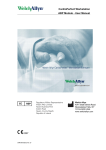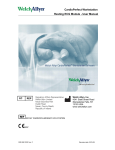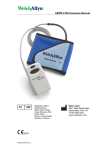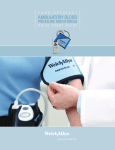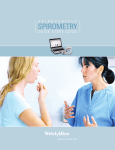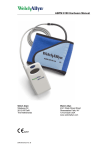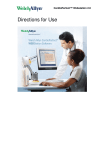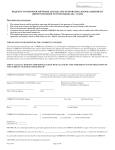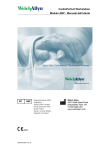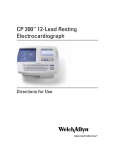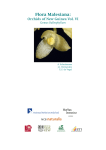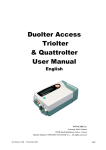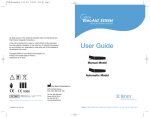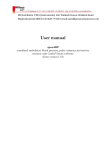Download Cardioperfect Workstation ABP Software, User Manual
Transcript
CardioPerfect Workstation ABP Module - User Manual Welch Allyn, Inc. 4341 State Street Road Skaneateles Falls, NY 13153 USA www.welchallyn.com 0297 DIR 80012332 Ver. F 1 / 38 CardioPerfect Workstation ABP Module - User Manual Copyright © Copyright 2014, Welch Allyn. All rights are reserved. To support the intended use of the product described in this publication, the purchaser of the product is permitted to copy this publication, for internal distribution only, from the media provided by Welch Allyn. No other use, reproduction, or distribution of this publication, or any part of it, is permitted without written permission from Welch Allyn. No one is permitted to translate, reproduce or duplicate this manual or any part thereof, in any form, without prior written permission from Welch Allyn. Welch Allyn assumes no responsibility for any injury to anyone, or for any illegal or improper use of the product, that may result from failure to use this product in accordance with the instructions, cautions, warnings, or statement of intended use published in this manual. Unauthorized copying of this publication may not only infringe copyright but also reduce the ability of Welch Allyn to provide accurate and up-to-date information to users and operators alike. ® ® ® Welch Allyn , CardioPerfect Workstation and SpiroPerfect are registered trademarks of Welch Allyn. Software in this product is Copyright 2014, Welch Allyn. All rights are reserved. The software is protected by United States of America copyright laws and international treaty provisions applicable worldwide. Under such laws, the licensee is entitled to use the copy of the software provided on the original distribution medium. The software may not be copied, decompiled, reverse-engineered, disassembled or otherwise reduced to humanperceivable form. This is not a sale of the software or any copy of the software; all right, title and ownership of the software remains with Welch Allyn. The information contained in this manual is subject to change without notice. All changes will be in compliance with regulations governing manufacture of medical equipment. User responsibility This product is designed to perform in conformity with the description thereof contained in this manual and accompanying labels and inserts, when assembled, operated, maintained and repaired in accordance with the instructions provided. A defective product should not be used. Parts that are broken, plainly worn, missing or incomplete, distorted or contaminated should be replaced immediately. Should any repair or replacement become necessary, we recommend that service be performed at the nearest approved service center. The user of the product shall have the sole responsibility for any malfunction, which results from improper use, faulty maintenance, improper repair, damage or alteration by anyone other than Welch Allyn or their authorized service personnel. Accessories The Welch Allyn warranty can only be honored if you use Welch Allyn approved accessories and replacement parts. Caution DIR 80012332 Ver. F Use of accessories other than those recommended by Welch Allyn may compromise product performance. 2 / 38 CardioPerfect Workstation ABP Module - User Manual Warranty, Service, and Spare Parts Warranty All repairs on products under warranty must be performed or approved by Welch Allyn. Unauthorized repairs will void the warranty. In addition, whether or not covered under warranty, any product repair shall exclusively be performed by Welch Allyn certified service personnel. Assistance and Parts If the product fails to function properly or if assistance, service, or spare parts are required, contact the nearest Welch Allyn Technical Support Center. USA Latin America European Call Center United Kingdom France Germany Netherlands 1-800-535-6663 (+1) 305-669-9003 (+353) 46-90-67790 Canada South Africa Australia 1-800-561-8797 (+27) 11-777-7555 (+61) 2-9638-3000 (+44) 207-365-6780 (+33) 1-55-69-58-49 (+49) 695-098-5132 (+31) 202-061-360 Singapore Japan China Sweden (+65) 6419-8100 (+81) 42-703-6084 (+86) 21-6327-9631 (+46) 85-853-65-51 Before contacting Welch Allyn it is helpful to attempt to duplicate the problem and to check all accessories to ensure that they are not the cause of the problem. When calling, please be prepared to provide: Product name and model number and complete description of the problem The serial number of your product (if applicable) The complete name, address and phone number of your facility For out-of-warranty repairs or spare parts orders, a purchase order (or credit card) number For parts order, the required spare or replacement part number(s) Repairs If your product requires warranty, extended warranty, or non-warranty repair service, please call first the nearest Welch Allyn Technical Support Center. A representative will assist you troubleshooting the problem and will make every effort to solve it over the phone, avoiding potential unnecessary return. In case the return cannot be avoided, the representative will record all necessary information and will provide a Return Material Authorization (RMA) number, as well as the appropriate return address. A Return Material Authorization (RMA) number must be obtained prior to any return. Note DIR 80012332 Ver. F Welch Allyn does not accept returned products without an RMA. 3 / 38 CardioPerfect Workstation ABP Module - User Manual Packing Instructions If you have to return goods for service, follow these recommended packing instructions: Remove all hoses, cables, sensors, power cords, and ancillary products (as appropriate) before packing, unless you suspect they are associated with the problem. Wherever possible use the original shipping carton and packing materials. Include a packing list and the Welch Allyn Return Material Authorization (RMA) number. It is recommended that all returned goods be insured. Claims for loss or damage to the product must be initiated by the sender. Limited Warranty Statement Welch Allyn, Inc. warrants that the Welch Allyn CardioPerfect Workstation computer based product you have purchased meets the labeled specifications of the Product and will be free from defects in materials and workmanship that occur within 1 year after the date of purchase. Accessories used with the Product are warranted for 90 days after the date of purchase. The date of purchase is: 1) the date specified in our records, if you purchased the Product directly from us, 2) the date specified in the warranty registration card that we ask you to send to us, or 3) if you don’t return the warranty registration card, 120 days after the date on which the Product was sold to the dealer from whom you bought the Product, as documented in our records. This warranty does not cover damage caused by: 1) handling during shipping, 2) use or maintenance contrary to labeled instructions, 3) alteration or repair by anyone not authorized by Welch Allyn, and 4) accidents. You assume all responsibility for the use of the Product with any hardware or software that does not meet the system requirements described in the Product documentation. If a Product or accessory covered by this warranty is determined to be defective because of defective materials, components, or workmanship, and the warranty claim is made within the warranty period described above, Welch Allyn will, at its discretion, repair or replace the defective Product or accessory free of charge. You must obtain a return authorization from Welch Allyn to return your Product before you send it to Welch Allyn’s designated service center for repair. THIS WARRANTY IS IN LIEU OF ALL OTHER WARRANTIES, EXPRESS OR IMPLIED, INCLUDING BUT NOT LIMITED TO THE IMPLIED WARRANTIES OF MERCHANTABILITY AND FITNESS FOR A PARTICULAR PURPOSE. WELCH ALLYN'S OBLIGATION UNDER THIS WARRANTY IS LIMITED TO REPAIR OR REPLACEMENT OF PRODUCTS CONTAINING A DEFECT. WELCH ALLYN IS NOT RESPONSIBLE FOR ANY INDIRECT OR CONSEQUENTIAL DAMAGES RESULTING FROM A PRODUCT DEFECT COVERED BY THE WARRANTY. DIR 80012332 Ver. F 4 / 38 CardioPerfect Workstation ABP Module - User Manual Table of contents 1. GETTING STARTED .................................................................................. 9 1.1 2. The ABP window ................................................................................................ 9 RECORDING AN ABP TEST.................................................................... 11 2.1 About recording ABP tests ................................................................................ 11 2.2 Record an ABP test .......................................................................................... 11 2.3 Read back measurements ................................................................................ 14 3. VIEWING AN ABP TEST .......................................................................... 16 3.1 View an ABP test .............................................................................................. 16 3.2 View and add information ................................................................................. 16 3.3 Views ................................................................................................................ 16 3.4 Measurements view .......................................................................................... 17 3.5 Hourly intervals view ......................................................................................... 19 3.6 Trends view ...................................................................................................... 20 3.7 Summary view .................................................................................................. 22 3.8 Scatter points view............................................................................................ 23 3.9 Rise and fall view .............................................................................................. 24 3.10 Zoom in on a graph ....................................................................................... 25 3.11 Exceeding norms view................................................................................... 25 3.12 Frequency distribution ................................................................................... 26 4. INTERPRETING AN ABP TEST ............................................................... 27 4.1 Edit and confirm an interpretation ..................................................................... 27 4.2 View interpretation history................................................................................. 28 5. 5.1 6. PRINTING AN ABP TEST ........................................................................ 29 About printing ABP tests ................................................................................... 29 CUSTOMIZE THE ABP MODULE ............................................................ 30 6.1 About customizing ............................................................................................ 30 6.2 ABP settings- General tab ................................................................................ 30 6.3 ABP settings- Printing tab ................................................................................. 31 6.4 ABP settings- Advanced tab ............................................................................. 31 6.5 Protocols .......................................................................................................... 32 DIR 80012332 Ver. F 5 / 38 CardioPerfect Workstation ABP Module - User Manual 6.6 Add or edit a protocol........................................................................................ 33 6.7 Customize abp.txt ............................................................................................. 34 6.8 Device overview ............................................................................................... 34 6.9 ABP error list .................................................................................................... 34 7. TROUBLESHOOTING .............................................................................. 36 8. FUNCTION KEYS ..................................................................................... 37 DIR 80012332 Ver. F 6 / 38 CardioPerfect Workstation ABP Module - User Manual General information Welcome Welcome to the ABP module, the ambulatory blood pressure module of the Welch Allyn CardioPerfect Workstation. The ABP module allows the user to easily record, view and print 24 hour ambulatory blood pressure tests. This manual contains specific information about the ABP module. These instructions must be studied before putting the unit into operation. For all general information about the workstation software please refer to the Workstation manual, this describes a.o.: - Creating and editing Patient cards - General information about printing For further information on installation and configuration please refer to the Workstation Installation and Configuration manual. Intended use The CardioPerfect Workstation (CPWS) software with associated accessories is indicated for the acquisition, analysis, formatting, display, printing and storage of certain physiologic signals, for the purpose of assisting the clinician in the diagnosis and monitoring of various diseases and/or treatment regimens. Using the optional ambulatory blood pressure (ABP) module of the Welch Allyn CardioPerfect Workstation (and associated accessories), the user can easily acquire, record retrieve, view and print 24 hour ambulatory blood pressure tests using the ABP recorder. The ABP recorder is an automated, microprocessor controlled blood pressure monitor, which monitors, accumulates and stores heart beat (rate), systolic and diastolic data of an individual adult or pediatric patient (in the patient’s environment) for a session which may last for up to 250 measurements. Indications Possible clinical indications for ambulatory blood pressure measurement: - Suspected white coat hypertension Suspected nocturnal hypertension To establish dipper status Resistant hypertension Elderly patient As a guide to antihypertensive drug treatment Type 1 diabetes Evaluations of hypotension Autonomic failure Masked hypertension Because of the widespread availability and application of the generic kind of device, the customer is assumed knowledgeable enough to determine if use of the device is indicated. DIR 80012332 Ver. F 7 / 38 CardioPerfect Workstation ABP Module - User Manual Contraindications and considerations Some patients find the cuff pressure intolerable, particularly those with very high blood pressure and who have frequent repeat readings. ABPM is uncommonly associated with any complications. Petechiae of the upper arm and sometimes bruising under the inflating cuff may occur, and sleep disturbance is fairly common. In general, ABP may not be accurate during exercise or when driving, or when the cardiac rate is irregular, as in atrial fibrillation. There may be technical reasons why ambulatory readings fail in some patients (e.g. problems with cuff fitting in patients with conical-shaped arms, movement artefact, tremor, weak or irregular pulse, auscultatory gap). [The Medical Journal of Australia 2002, 176(12), p. 588-592, Barry P McGrath] Note: for recorder specific information please refer to the appropriate hardware manual. DIR 80012332 Ver. F 8 / 38 CardioPerfect Workstation ABP Module - User Manual 1. Getting started 1.1 The ABP window The ABP window is the central part of the ABP module. Search area Toolbar Menu bar Title bar Workspace Status bar Title bar The title bar displays the name of the program. The title bar contains three buttons that you can use to maximize, minimize and close the ABP window. Menu bar Each menu in the menu bar contains a number of tasks that you can perform with the ABP module. Sometimes, menus are gray. This means that you cannot access that functionality at that particular point, either because it is not available, or because you are not authorized to use it. Tool bar The tool bar contains buttons that give you easy access to the most common tasks in ABP, such as recording and printing a test, reading back the measurements, interpretation and test information. Search area The search area on the left hand side contains search and display functionality that lets you easily retrieve patients and tests. In the search area, you can find a patient, see which tests were recorded for that patient and see the kind of tests that were recorded. You can also create search patterns, an easy way of finding information that you need frequently. DIR 80012332 Ver. F 9 / 38 CardioPerfect Workstation ABP Module - User Manual Workspace The workspace displays tests and test related data, such as interpretations, measurements and comments. This is where you will do the actual recording, viewing and interpretation. The ABP workspace contains a viewing area with a number of tabs that let you see different aspects of the test. The tabs, also called views, that are available are: Measurements, Hourly intervals, Trends, Summary, Scatter points, Rise and fall and Exceeding norms. Shortcut menu In the workspace, you can use a shortcut menu to access the most common tasks. You can access these tasks by clicking on the workspace with your right mouse button. Status bar DIR 80012332 Ver. F The status bar at the bottom of the window shows the current user. 10 / 38 CardioPerfect Workstation ABP Module - User Manual 2. Recording an ABP test 2.1 About recording ABP tests An ambulatory blood pressure test consists of two parts: Starting a test and preparing the ABP recorder for use. Reading back the recorded measurements to the computer. Please refer to the hardware manuals for instructions on how to handle and maintain the recorder. 2.2 Record an ABP test Follow these global steps. Each step is explained in more detail on the following pages. To record an ABP test: 1. Connect the blood pressure recorder to your computer. 2. Select a patient, or create a new one. 3. In the File menu, point to New, and click Ambulatory blood pressure. The ABP module starts to communicate with the ABP recorder. 4. If two devices are connected select which device should be used for the recording in the window that pops up. 5. If the Name new device dialog box is displayed, enter the name of the blood pressure recorder. DIR 80012332 Ver. F 11 / 38 CardioPerfect Workstation ABP Module - User Manual 6. After this step, a number of situations can occur: If the recorder... Continue with... Is empty Enter patient and protocol information Does contain measurements from Store previously recorded measurements. previous tests. Enter patient and protocol information 7. Disconnect the blood pressure recorder from your computer and place it in the pouch. The patient wears the recorder for 24 hours. 8. When the patient returns, connect the blood pressure recorder to the computer again, and read back the measurements. Enter patient and protocol information Before you can record an ABP test, you first need to enter patient and protocol information. This information is saved together with the recording. You can enter patient and protocol information in the New Ambulatory Blood Pressure Test dialog box. This dialog box is displayed: - Immediately when you start a new test with an empty ABP recorder. - After deleting the measurements when you start a new test with an ABP recorder that was not empty. To enter patient and protocol information: 1. From the Specialty list, select the specialty of the physician that ordered the test. 2. From the Referring physician list, select the name of the physician that ordered the test. 3. From the Protocol list, select the protocol that you want to use for the test. 4. Click OK. The ABP module shows that the test is in progress. DIR 80012332 Ver. F 12 / 38 CardioPerfect Workstation ABP Module - User Manual Please refer to chapter 6.5 and 6.6 for more information on protocols and the protocol editor. Store previously recorded measurements The recorder can contain measurements from previously recorded tests. You can choose to save those measurements to the database before deleting them from the recorder. How the measurements are saved depends on the patient for which the measurements were recorded. If the measurements belong to... The current patient Another patient An unknown patient Then you can... Read back the measurements and save them to the patient's test in progress. Assign the measurements to a test in progress for that patient. Create a new patient and assign the measurements to the new test for that patient. To read back the measurements and save them to the patient's previous test: 1. If you try to record a test for a patient who already has a test in progress, the following message is displayed: 2. Click Yes. The measurements are read from the ABP recorder and saved to the patient's previous test. Note: if you click No, you cannot start a new test for the current patient, because a patient can only have one test in progress. To assign the measurements to a test of another patient: 1. If you want to record a test for the current patient, but the ABP recorder still contains measurements of another patient, the following message is displayed: DIR 80012332 Ver. F 13 / 38 CardioPerfect Workstation ABP Module - User Manual 2. Click Yes. The measurements are assigned to the patient that is mentioned in the message. The New ambulatory blood pressure test dialog box is displayed, so that you can continue with recording a test for the current patient. Note: if you click No, the measurements are deleted from the ABP recorder without being saved. To assign the measurements to a new patient: 1. If you want to record a test for the current patient, but the ABP recorder still contains measurements of an unknown patient, the following message is displayed: 2. Click Yes. A new patient card is created. This card only contains a patient number. The New ambulatory blood pressure test dialog box is displayed, so that you can continue with recording a test for the current patient. Note: if you click No, the measurements are deleted from the ABP recorder without being saved. 2.3 Read back measurements When the patient has returned, you need to read back the measurements and transfer them to the computer. Once you have transferred the measurements to the computer, you can view them in the ABP module. To read back the measurements and save them on your computer: 1. Connect the ABP recorder to your computer. The In progress dialog is displayed. 2. Press the Read measurements button. The Ambulatory Blood Pressure Measurements read back dialog box is displayed. DIR 80012332 Ver. F 14 / 38 CardioPerfect Workstation ABP Module - User Manual 3. This dialog box displays the specialty and the name of the referring physician that ordered the test. In addition, it shows: The period that the patient was asleep. The number of measurements or events that were recorded. 4. The sleeping period is set to the default settings that were entered in the ABP settings. You can change the values to that they reflect the patient's actual sleeping period. 5. Decide whether you want to delete the measurements from the ABP recorder. If you want to delete the measurements, select the option at the bottom of the dialog box. 6. Press OK to transfer the measurements to the computer and save them with the patient that is mentioned at the top of the dialog box. Note: if you click the Cancel button, the measurements are not transferred to the computer. The test remains in progress. Tips for reading back measurements: You can also read back the measurements by clicking the Read back button on the toolbar, if the ABP module is activated. This way, you do not need to select the patient before reading back the measurements, which speeds up the reading back process. DIR 80012332 Ver. F 15 / 38 CardioPerfect Workstation ABP Module - User Manual 3. Viewing an ABP test 3.1 View an ABP test To view an ABP test: 1. In the patient list, select the patient whose test you want to view. The tests that have been recorded for that patient are listed in the test list. 2. From the test list, select the ABP test that you want to see. ABP tests are indicated with . The ABP module is started automatically, and the test is displayed in the workspace. 3.2 View and add information You can view information that was entered when the test was recorded. Additionally, you can add your own comments. To view information about the test: In the Tools menu, click Information. The Information dialog box is displayed. To enter your own comments: 3.3 In the Comment section of the Information dialog box, start typing and click OK. Views With the ABP module, you can view ABP test results in seven different views: Measurements and events Hourly intervals Trends Summary Scatter points Rise and fall Exceeding norms Frequency distribution DIR 80012332 Ver. F 16 / 38 CardioPerfect Workstation ABP Module - User Manual 3.4 Measurements view The Measurements view displays a list of measurements and events. Measurements are automatically made by the ABP recorder. Events are created when the patient presses the button on the recorder. Information For each measurement, the following information is presented: Number, date and time of the recording. Systolic and diastolic pressure. Mean arterial pressure (MAP) Heart rate Pulse pressure Rate pressure product (RPP= systolic pressure * heart rate) Comment Norm values Values that are above the norm values are displayed in bold red text. Sleeping period Measurements that were recorded when the patient was asleep are displayed in the grayed area of the view. Working with the Measurements view In the Measurements view, you can: Assign measurements to the sleeping or waking period Add a comment to a measurement Temporarily hide a measurement from a test Delete a measurement DIR 80012332 Ver. F 17 / 38 CardioPerfect Workstation ABP Module - User Manual Assign measurements to the waking or sleeping period The measurements in an ABP test are divided into two categories: Measurements that were taken when the patient was awake (waking period). Measurements that were taken when the patient was asleep (sleeping period). This is done according to the default ABP settings. Usually this division consists of an 8hour night and a 16-hour day. When you read back the measurements, you can change the sleeping period values so that they reflect the patient's actual sleeping period. You can change the period to which a measurement was assigned. This can be necessary, for instance when the patient has not slept very well and decided to read a book. He might also have decided to sleep in. To assign a measurement from the sleeping period to the waking period: 1. Right click on the measurement that you want to assign to the waking period. 2. In the shortcut menu, click Set awake. The gray shade is removed from the measurement to indicate that the patient was awake when this measurement was taken. To assign measurements from the waking period to the sleeping period: 1. Right click on the measurement that you want to assign to the sleeping period. 2. In the shortcut menu, click Set asleep. A gray shade is added to the measurement to indicate that the patient was asleep when this measurement was taken. Add a comment When you want to make note of something in a measurement, you can add a comment to that measurement. To add a comment: 1. In the Measurements view, click on Comment field of the measurement to which you want to add the comment. The field becomes active, and a pointer appears, click again on the field and a cursor appears. 2. Enter your comment. The comment is automatically saved with the test. Temporarily hide a measurement from a test When you do not want to view a measurement, but do not want to delete it from the test either, you can temporarily hide it. To temporarily hide a measurement: 1. In the Measurements view, click the measurement that you want to hide. 2. Right click on the measurement. In the shortcut menu, click Exclude. The measurement number is put between brackets to indicate that this measurement is not used in the test at the moment. The measurement is not used in any of the measurements or graphs in the other views. DIR 80012332 Ver. F 18 / 38 CardioPerfect Workstation ABP Module - User Manual 3. Click Include to make the measurement part of the test again. Delete a measurement When a measurement or event is not valid, you can delete it from the test. To delete a measurement: 1. In the Measurements view, right click on the measurement. 2. In the shortcut menu, click Delete. The measurement is deleted from the test. It is not used in any of the views any longer. 3.5 Hourly intervals view The Hourly intervals view displays the average of a number of values and their corresponding standard deviations at intervals of 1, 2, 3, 4, 6 or 8 hours. Information The averages of the following values are displayed: Systolic pressure Diastolic pressure Heart rate The percentage of successfully completed measurements is also displayed. Working with the Hourly intervals view In the Hourly intervals view, you can change the intervals for which the values are displayed. To change the intervals for which the values are displayed: Click on one of the interval buttons at the top of the Hourly interval view. The interval is changed. DIR 80012332 Ver. F 19 / 38 CardioPerfect Workstation ABP Module - User Manual 3.6 Trends view The Trends view shows a graphical representation of the ABP test. Information The upper chart displays the systolic pressure, MAP (when selected) and diastolic pressure The lower chart displays the heart rate Norm values Upper and lower norm values are displayed in dotted lines. Sleeping period Measurements that were recorded when the patient was asleep are displayed in the grayed area of the view. Working with the trends view In the Trends view, you can: View the exact values with the measurement slider Compare ABP tests Zoom in on parts of the trends graph (see §3.10 ) View exact values in the Trends view The Trends view displays information in a graph. You can see the exact values of a point in the graph with the measurements slider. This is a vertical line that you can slide over the graph. The exact values for the points in the graph are displayed on the right hand side of the Trends view. DIR 80012332 Ver. F 20 / 38 CardioPerfect Workstation ABP Module - User Manual Exact value for points at slider position Slider The measurements slider only gives exact values for 30 minutes intervals. Compare ABP tests of the same patient In the Trends view, you can compare the current ABP record with a previous recorded test of the same patient. To make a comparison: 1. Right click on the graph. 2. In the shortcut menu, click Comparison. 3. In the Comparison dialog box select the test with which you want to compare the current test and click OK. 4. The graphs for both tests are shown in the Trends view window. To return to the current test, click Comparison in the shortcut menu and click on the selected test. DIR 80012332 Ver. F 21 / 38 CardioPerfect Workstation ABP Module - User Manual 3.7 Summary view The Summary view displays statistics for general information, systolic pressure, diastolic pressure and heart rate. For each of the statistics, the values are given for the waking period, the sleeping period and the entire test. Information The general statistics consist of: Number of measurements Percentage of successfully completed measurements Total recording time Average blood pressure Standard deviation of the blood pressure Average pulse pressure The systolic and diastolic pressure statistics consist of: Number of measurements that is greater than or equal to the norm value that is displayed in the field. Minimum value that was measured Maximum value that was measured The heart rate statistics consist of: Average Standard deviation Minimum heart rate that was measured Maximum heart rate that was measured Awake/asleep decrease The decrease in blood pressure in the sleeping period compared to the blood pressure in the awake period is expressed in the decrease percentages at the bottom of the view. Morning average The average blood pressure in the first hour after the sleep period is expressed in the morning average at the bottom of the view. DIR 80012332 Ver. F 22 / 38 CardioPerfect Workstation ABP Module - User Manual Working with the summary view In the Summary view, you can: Change the norm values for the systolic and diastolic blood pressure, and see how many measurements are above the norm value. Change the norm values The Summary view displays how many measurements are greater than or equal to the norm values. The norm values are set as a default in the ABP module. You can change the norm values for one test. To change the norm values: In the Summary view, enter a new norm value in one of the norm value fields. 3.8 Scatter points view A scatter plot reveals relationships or association between two variables. Such relationships manifest themselves by any non-random structure in the plot. The Scatter points view displays the correlation between the following values: Systolic pressure against heart rate Diastolic pressure against heart rate MAP against heart rate Systolic pressure against diastolic pressure Information One point on a graph represents one measurement. Black points were measured during the sleeping period. DIR 80012332 Ver. F 23 / 38 CardioPerfect Workstation ABP Module - User Manual Sleeping period Each correlation graph can be displayed for all measurements, measurements for the sleeping period or measurements for the awake period. Working with the Scatter points view In the Scatter points view, you can: Toggle between one graph or all graphs. Zoom in on a graph (see §3.10 ). Toggle between one or all graphs In the Scatter point view, the default view displays all four scatter point graphs. You can display each graph individually by clicking the graph names at the top of the Scatter point view. You can also select whether you want to see the overall measurements, measurements for the sleeping period or measurements for the waking period. 3.9 Rise and fall view The Rise and fall view displays values for the rise and fall of the blood pressure during the test. Information The upper chart displays: The diastolic and systolic pressure and MAP values. A rise and fall curve. This curve is obtained by filtering the MAP curve. DIR 80012332 Ver. F 24 / 38 CardioPerfect Workstation ABP Module - User Manual The lower chart displays: A first derivation of the filtered MAP curve. This derivation clearly displays the rise and fall of the blood pressure. Sleeping period The measurements that were recorded during the sleeping period are displayed in the grayed area. Working with the Rise and fall view In the Rise and fall view, you can: Zoom in on a graph (see §3.10 ). 3.10 Zoom in on a graph In the Trends view, the Scatter points view and the Rise and fall view, you can zoom in on a part of the graph. To zoom in on a graph: 1. Position your mouse near the area that you want to enlarge. 2. Click your mouse button and keep it pressed. When you move the mouse from the top left corner to the bottom right corner of the graph, a square is drawn. 3. Drag the square over the area that you want to enlarge. The area is enlarged. To reset the zoom: 1. Right click on the graph. 2. In the shortcut menu, click Reset zoom. The graph is restored to its original size. 3.11 Exceeding norms view The Exceeding norms view displays the percentages of measurements that are Normal (less or equal than the norm value) Acceptable (range [100 – 125] % of the norm value) Critical (greater than 125% of the norm value) See paragraph 6.2 ‘ABP settings- General tab’ on page 30 for the norm value. The percentages are displayed in pie charts, both for systolic and diastolic pressure. DIR 80012332 Ver. F 25 / 38 CardioPerfect Workstation ABP Module - User Manual 3.12 Frequency distribution In the Frequency distribution window the frequencies of the systolic and diastolic pressure are shown divided in 10 mmHg bins. The Heart rate frequencies are shown divided in 10 bpm bins. You can select whether you want to see the overall graphic, the graphic for the sleeping or the waking period and select which percentage is shown. DIR 80012332 Ver. F 26 / 38 CardioPerfect Workstation ABP Module - User Manual 4. Interpreting an ABP test 4.1 Edit and confirm an interpretation You can edit an interpretation in the Interpretation editor. In this editor, you can enter your own texts. Alternatively, you can use the statement tree to select and enter common interpretation statements. Once you edit an interpretation, you must confirm it. Otherwise, your changes will not be saved. To edit and confirm an interpretation manually: 1. In the Tools menu, click Interpretation. The Interpretation editor is displayed. 2. In the right hand pane, at the pointer, start typing. 3. Click the Confirm button to save your comments and to return to the ABP test. To edit and confirm an interpretation with the statement tree: 1. In the Tools menu, click Interpretation. The Interpretation editor is displayed. 2. From the statement tree, click on one of the categories to display all possible statements for that category. 3. From a category, click on the statement that you want to include in the interpretation. The statement is added. 4. To delete a statement from the interpretation, select the statement text and press BACKSPACE to delete it. 5. Click the Confirm button to save your comments and to return to the ABP test. Tips for editing and confirming an interpretation: You can automatically insert the current date and time by clicking the Date/time button. You can clear the interpretation editor by clicking the Clear button. DIR 80012332 Ver. F 27 / 38 CardioPerfect Workstation ABP Module - User Manual 4.2 View interpretation history When you change something in an interpretation, the ABP module does not change the original interpretation, but creates a new one. This way, you never lose any information. A copy of all interpretations is kept in the interpretation history. To view the interpretation history: 1. In the Tools menu, click History. The Interpretation history window is displayed. 2. The left hand pane displays the interpretations sorted by date. The right hand pane shows the content of each interpretation, plus the interpretation date, time and editor. 3. Click on a date to view an interpretation. DIR 80012332 Ver. F 28 / 38 CardioPerfect Workstation ABP Module - User Manual 5. Printing an ABP test 5.1 About printing ABP tests With the ABP module, you can print ABP tests on plain paper with an regular inkjet or laser printer. You can choose from a number of formats in which you want to print the information. Each print format has a header that contains additional information. With the Print preview function, you can see what a printed ABP test will look like on paper. Print formats The ABP module can print the following formats: Trends Summary Scatter points Scatter points awake Scatter points asleep Rise and fall Measurements Hourly intervals Hourly intervals with an interval of 2, 3, 4, 6 or 8 hours Frequency distributions Frequency distributions asleep or awake Exceeding norms Each format contains the view and a header that displays additional information. You can print several formats at the same time. If among others the Summary report is selected in the default report templates in the ABP printing settings tab, the summary report will be printed first. Please refer to the Workstation manual for further information on printing tests. DIR 80012332 Ver. F 29 / 38 CardioPerfect Workstation ABP Module - User Manual 6. Customize the ABP module 6.1 About customizing You can adjust various ABP settings to your own needs and wishes. You can, for example, change the norm values for diastolic and systolic pressure, set the dipping percentage or select the formats that you want to use with the Print selected formats function. The features that you can customize are located in the ABP settings. To open the ABP settings: 1. In the File menu, click Settings. The Settings dialog box is displayed. 2. Click Ambulatory Blood Pressure. Protocols 6.2 To add and edit protocols, use the Protocol editor. ABP settings- General tab Use the General tab to customize the norm values, default sleeping time and dipping definitions. The General tab contains the following information: Norm values The norm values that are used by the ABP module to compare measurements. You can set norm values for diastolic and systolic pressure, for both sleeping and waking periods. Default sleeping time The period that is used as the default sleeping time. You can always manually assign measurements to sleeping and waking time. Dipping The percentage at which the blood pressure dips DIR 80012332 Ver. F 30 / 38 CardioPerfect Workstation ABP Module - User Manual 6.3 ABP settings- Printing tab Use the Printing tab to select the formats that you want to use for the Print selected formats function. The Printing tab contains the following information: Default report templates Here, you can select the formats that you want to print when you use the Print selected formats function. You can select multiple formats. Print after the measurements are read back from the device If selected the ABP test is automatically printed when the measurements are read back from the device. The formats that are selected in the Default report templates area are printed. 6.4 ABP settings- Advanced tab Use the Advanced tab to select the Recording device and the COM port for the ABP recorder. The Advanced tab contains the following information: Recording device DIR 80012332 Ver. F Enable the ABPM 7100, ABPM 6100, ABP Perfect, or all of the devices. If you have selected more than one device, a window will pop up when you want to make a new recording in which you can select which device to use. 31 / 38 CardioPerfect Workstation ABP Module - User Manual Connected to Use safe initialization Max. inflation pressure Enable start button Auto erase 6.5 From this list, you can select the port to which the ABP recorder is connected. Use this option if the ABP Perfect recorder has problem communicating with the ABP program. Allows you to select the maximum pressure that the unit will inflate the cuff to in mmHg. If selected a measurement can be manually started with the start button. If not, this can only be done in the first 30 minutes. When you select this option, the measurements are automatically erased from the device after storing them into the database. Protocols A protocol is an important part of the ABP module. It contains information about when the ABP recorder must record a measurement. A protocol contains a number of stages. Each stage contains the following information: Start time: the time the stage becomes active. Time interval: time in minutes between two measurements. Measurements time interval (minutes): The interval in minutes between successive measurements recorded in this stage. Buzzer: whether the buzzer should play a sound when a recording is made. This way, the patient can prepare himself and reduce the possibility of an error measurement. If an error measurement occurs, a repeated measurement is taken at exactly 3 minutes after the error measurement. You can add and edit protocols in the Protocol editor. DIR 80012332 Ver. F 32 / 38 CardioPerfect Workstation ABP Module - User Manual 6.6 Add or edit a protocol With the protocol editor, you can add new protocols or edit existing ones. Adding a protocol consists of two parts: Creating the protocol Adding stages to the protocol. To create a new protocol: 1. In the Tools menu, click Protocol editor. The Protocol editor is started. Device selection box Protocol tree Stages list 2. In the Device selection box, select which type of protocol you want to create. Either a protocol for the ABPM 6100, or for the ABPM 7100, or for all. 3. Right click on the Protocol tree. 4. In the shortcut menu, click New. A new empty protocol is added to the Protocol tree. 5. Enter a meaningful name for the new protocol. To add a stage to the protocol: 1. Right click in the stages list. 2. In the shortcut menu, click New. The Time interval editor is started. 3. Enter the time at which the stage must start. 4. Enter the interval (minutes) between recordings in this stage. 5. If you want the buzzer to play a sound before recording, select the Buzzer option. 6. If you want the measurement to be displayed on the ABP recorder right after it was recorded, select the Show measurements on device option. DIR 80012332 Ver. F 33 / 38 CardioPerfect Workstation ABP Module - User Manual To edit a stage: 1. In the stages list, double click on the stage that you want to edit. The Time interval editor is started. 2. Change the information 6.7 Customize abp.txt You can customize the statements that are used in the Interpretation editor according to your own preferences. To customize the statements: 1. Use Notepad to open the file abp.txt. As a default, this file is located in C:\program files\cardio control\mdw\modules\resources\0009 (English) or \0013 (Dutch). 2. Edit, add and delete the statements according to your own preferences. Abp.txt consists of statements that are grouped in categories. The statements are listed under the category name they belong to. Statements indent one position. To create a new category: 1. Type the name of the new category on the first position of a new line. 2. Enter the statements you want to add to this category on new lines, make sure that each statement indents one character. 6.8 Device overview The device overview displays the ABP devices that are currently in use, the patients to whom they are assigned and the times when recordings have started. To view the Device overview: 6.9 In the Tools menu, click Device overview. The Device overview is displayed. ABP error list In the error list you can see the errors that can occur during the test recording as shown by the software. The error list dialog consists of two items: Number of the error Explanation An error can occur because of a number of reasons. Most of the reasons are listed in the explanations. DIR 80012332 Ver. F 34 / 38 CardioPerfect Workstation ABP Module - User Manual Error Description 1 Unknown error 2 This can indicate one of the following problems: 3 After 2 seconds the pulse has not reached the falling level. Heart frequency has not reached its defined range. Variation of the heart frequency is too large. Less than 4 measurements were taken. The rising level was not reached within 2 seconds after the falling level. Pulse bandwidth is out of range. Movement artifact. Maximum number of beats encountered in a stage. This can indicate one of the following problems: The heart frequency was out of range in more than 3 pressure stages. The difference between systole and diastole was too small. The systole is considerably bigger than the pump pressure. An oscillation value was smaller than the start or end value. The pulse bandwidth is smaller than at start or end point. The MAP is out of range. The systole is out of range. The diastole is too large. The number of stages is too large. The oscillation value is too large. The total time is too long. A function took too much time. 4 The battery voltage is too low. 5 No cuff was detected. 6 Too many measurements were taken -orNo memory was available in EEPROM 7 No measurements are available. -orThe measurements were stopped. 8 Hardware failure -orError at zero alignment or pumping started unexpectedly. Note: The codes mentioned above are the codes as listed by the software. These can differ from the codes in the LCD display of the ABPM 6100. The latter ones are for reference only, the error codes used in the software module as listed above are the error codes which correctly identify the possible error status. DIR 80012332 Ver. F 35 / 38 CardioPerfect Workstation ABP Module - User Manual 7. Troubleshooting When creating a new ABP test, the computer tells me that there is no response from the hardware: Check if there are fresh batteries in the device Check if the device is plugged in Check if the COM-port settings in the CPWS settings menu correspond with the actually used COM port While using the ABP Perfect: Check if “co” is displayed on the display of the ABP Perfect (see below for further checking) Try switching on “Use safe initialization” in the advanced part of the ABP settings menu The ABPM 7100 or ABP Perfect unit does not display “co” after it has been connected to the computer: Check if there are fresh batteries in the device Switch the device off and on once more to make sure the device was switched on after the device has been connected to the computer Measurement fails repeatedly: Make sure the chosen cuff fits the patients arm correctly Check if the cuff is (still) positioned correctly Try a measurement with the cuff on the other arm If the pump does not seem to work, try again with fresh batteries To determine whether the device works at all, try a measurement on a (test) person who has been successfully tested before. An error code appears on the display of the ABP unit: See the list of possible errors on page 34. DIR 80012332 Ver. F 36 / 38 CardioPerfect Workstation ABP Module - User Manual 8. Function keys The Welch Allyn CardioPerfect module is, just like all Windows applications, designed for working with the mouse. However, there might be situations in which working with the keyboard can be quicker. Therefore a number of functions within the Welch Allyn CardioPerfect module can also be selected directly using the keyboard. Here is a list of all available keyboard shortcuts in this module, for a more general function key description please refer to the Workstation manual: ABP specific functions Key Function [SHIFT]+[CTRL]+[B] Starts a new ABP recording. F2 Start new test [CTRL]+[I] Opens the Interpretation window DIR 80012332 Ver. F 37 / 38 CardioPerfect Workstation ABP Module - User Manual Index ABP test ................................................ 11 ABP window ........................................... 9 Add comment ....................................... 18 Advanced tab ........................................ 31 Assign measurements .................... 13, 14 Awake/asleep ....................................... 22 Buzzer................................................... 33 Change ................................................. 23 norm values ...................................... 23 Clear button .......................................... 27 COM ..................................................... 31 Comment .............................................. 18 Confirm ................................................. 27 Confirm interpretation ........................... 27 Date/time button ................................... 27 Delete ................................................... 19 measurement .................................... 19 Edit........................................................ 33 protocol ............................................. 33 Exceeding ............................................. 25 norms view ........................................ 25 Exclude ................................................. 18 General tab ........................................... 30 Graph .............................................. 21, 25 Hourly intervals view............................. 19 Include .................................................. 18 Interpretation history ............................. 28 Interpretations ................................... 9, 27 confirm .............................................. 27 MAP .................................... 17, 20, 23, 24 filtering .............................................. 24 Measurement .................................. 18, 19 DIR 80012332 Ver. F Delete ............................................... 19 Temporarily hide ............................... 18 Measurements view ............................. 17 Name new device ................................. 11 New ABP Test dialog ........................... 12 Norm values ......................................... 23 Change ............................................. 23 Patient information ............................... 12 Print formats ......................................... 29 Printing tab ........................................... 31 Protocol .......................................... 32, 33 edit .................................................... 33 Protocol information ............................. 12 Protocol list ........................................... 12 Read back measurements ............. 13, 14 Record ............................................ 11, 12 ABP test ...................................... 11, 12 Reset zoom .................................... 21, 25 Rise ................................................ 21, 25 RRP ...................................................... 17 Scatter points view ............................... 23 Shortcut keys ........................................ 37 Sleeping period .............................. 17, 18 Store previously recorded.. .................. 13 Summary .............................................. 23 Summary view ...................................... 22 Trends ............................................ 21, 25 Trends view .......................................... 20 View interpretation history .................... 28 Waking period ...................................... 18 Zoom .............................................. 21, 25 38 / 38






































